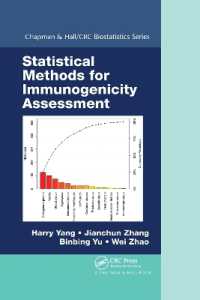- ホーム
- > 洋書
- > 英文書
- > Science / Mathematics
Full Description
Neural Networks in Robotics is the first book to present an integrated view of both the application of artificial neural networks to robot control and the neuromuscular models from which robots were created. The behavior of biological systems provides both the inspiration and the challenge for robotics. The goal is to build robots which can emulate the ability of living organisms to integrate perceptual inputs smoothly with motor responses, even in the presence of novel stimuli and changes in the environment. The ability of living systems to learn and to adapt provides the standard against which robotic systems are judged. In order to emulate these abilities, a number of investigators have attempted to create robot controllers which are modelled on known processes in the brain and musculo-skeletal system. Several of these models are described in this book.
On the other hand, connectionist (artificial neural network) formulations are attractive for the computation of inverse kinematics and dynamics of robots, because they can be trained for this purpose without explicit programming. Some of the computational advantages and problems of this approach are also presented.
For any serious student of robotics, Neural Networks in Robotics provides an indispensable reference to the work of major researchers in the field. Similarly, since robotics is an outstanding application area for artificial neural networks, Neural Networks in Robotics is equally important to workers in connectionism and to students for sensormonitor control in living systems.
Contents
Section I Trajectory Generation.- 1. Learning Global Topological Properties of Robot Kinematic Mappings for Neural Network-based Configuration Control.- 2. A One-eyed Self Learning Robot Manipulator.- 3. A CMAC Neural Network for the Kinematic Control of Walking Machine.- 4. Neurocontroller Selective Learning from Man-in-the-Loop Feedback Control Actions.- 5. Application of Self-Organizing Neural Networks for Mobile Robot Environment.- 6. A Neural Network Based Inverse Kinematics Solution in Robotics.- 7. Hopefield Net Generation and Encoding of Trajectories in Contained Environment.- Section II - Recurrent Networks.- 8. Some Preliminary Comparisons Between a Neural Adaptive Controller and a Model Reference Adaptive Controller.- 9. Stable Nonlinear System Identification Using Neural Network Models.- 10. Modeling of Robot Dynamics by Neural Networks with Dynamic Neurons.- 11. Neural Networks Learning Rules for Control: Uniform Dynamic Backpropagation, and the Heavy Adaptive Learning Rule.- 12. Parameter Learning and Compliance Control Using Neural Networks.- 13. Generalisation and Extension of Motor Programs for a Sequential Recurrent Network.- 14. Temporally Continuous vs. Clocked Networks.- Section III - Hybrid Controllers.- 15. Fast Sensorimotor Skill Acquisition Based on Rule-Based Training of Neural Nets.- 16. Control of Grasping in Robot Hands by Neural Networks and Expert Systems.- 17. Robot Task Planning Using a Connectionist/Symbolic System.- Section IV - Sensing.- 18. Senses, Skills, Reactions and Reflexes Learning Automatic Behaviors in Multi-sensory Robotic Systems.- 19. A New Neural Net Approach to Robot 3D Perception and VisuoMotion Coordination.- 20. Connectivity Graphs for Space-Variant Active Vision.- 21. Competitive Learning for Color Space Division.- 22. Learning to Understand and Control in a World of Events.- 23. Self-selection of Input Stimuli for Improving Performance.- Section V - Biological Systems.- 24. A biologically-Inspired Architecture for Reactive Motor Control.- 25. Equilibria Dynamics of a Neural Network Model for Opponent Muscle Control.- 26. Developmental Robotics'- A New Approach to the Specification of Robot Programs.- 27. A Kinematics and Dynamics Robot Control System Based on Cerbro-cerebellar Interaction Modelling.- 28. What Frogs' Brains Tell Robots' Schemas.- 29. Modulation of Robotic Motor Synergies Using Reinforcement Learning Optimization.- 30. Using Optimal Control to Model Trajectory Formation and Perturbation Response in a Prehension Task.








